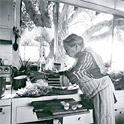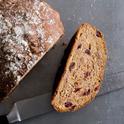Pâte à Savaritt
Dissolve 1 cake or envelope of yeast in ½ cup lukewarm water. Sift 1 ½ cups flour into a warm bowl, add the dissolved yeast, 2 large (or 3 small) eggs and ¼ to ½ cup lukewarm milk. Work the mixture until it is elastic, adding enough milk to make a very soft dough, much softer than brioche dough. Cover the dough with a towel, put it in a warm plate and let it rise until double in bulk, or for about 45 minutes Knead ¼ pound butter until it is as soft as heavy cream. When the dough rises, punch it down and add the butter, ½ teaspoon salt and 1 tablespoon sugar. Mix all together well. Turn the dough into a large, buttered ring mold. The mold should be about half full. Put the savarin in a warm place to rise. When it has risen almost to the top of the mold, bake it in a hot oven (425° F.) until it is brown, or for about 18 to 20 minutes. As soon as the cake is done, loosen it from the sides of the mold with a small sharp knife and remove it from the mold.
Make a light syrup by cooking 1 cup sugar with 1 cup water for 5 minutes. Add 2 or 3 tablespoons kitsch or mm and pour and spread this syrup over the warm cake. Sprinkle another tableSpoon or two of the same spirit over the cake and decorate it to taste with almonds and candied fruit. If desired the top may also be spread with apricot sauce. Serve warm.
Pâte à Baba
Follow the recipe for savarin, adding to the dough 2 tablespoons dried currants and 1 tablespoon raisins, Babas may be made in deep individual molds or in popover pans.
Bugnes
Dissolve 1 cake or envelope of yeast in ½ cup lukewarm water and combine this liquid with 1 cup flour to make a ball of dough. Cut a cross on the top of the ball, drop the ball into a deep bowl filled with warm water and let it stand until it rises to the surface. Meanwhile, sift together in a bowl 3 cups flour, ½ teaspoon salt and 2 tablespoons sugar. Add 6 eggs, a generous ¼ pound well-kneaded butter and 2 tablespoons cognac or rum and work them well into the dough. Continue to work all together until the mixture is very elastic. When the sponge rises to the surface of the water, add it to the dough in the bowl, cutting and folding it in without working the mixture any further. The dough should befirmer than brioche dough. Cover the dough with a towel and let it rise at room temperature until it doubles in bulk. Punch it down, forming it into a large ball. Break off pieces the size of small eggs and shape them into balls. Arrange the balls on a floured baking sheet and let them rise until they double in bulk. Fry them until brown in deep hot fat (375° F. on the fat ther mometer). Drain them on paper towels.
Pomponnettes an Kirsch
Half fill small round molds shaped like charlotte molds with baba dough with raisins in it. Let the dough rise to the top of the molds and bake in a hot oven (425° F.) for 7 to 8 minutes. Remove the cakes from the molds and dip them in a sugar syrup flavored with kirsch as in the recipe for savarin (see page 57). Drain them on a rack, sprinkle them with a little kirsch and glaze them with confectioners' sugar icing, half white and half pink.
Croissants
Dissolve 2 cakes or envelopes of yeast in 1/3 cup lukewarm water, add 1 cup flour and Form the dough into a ball. Cut a cross in the top and drop the ball into a deep bowl of warm water. Sift 3 cups flour, ½ teaspoon salt and 1 tablespoon sugar onto a wooden pastry board. Make a well in the center of the flour and add gradually 1 ½ cups lukewarm milk, stirring and mixing it in. Work the mixture until it becomes elastic. The dough for croissants should not be as soft as a brioche dough. When the ball of sponge has risen to the surface of the water, add it to the dough, cutting and folding it in. Working the dough at this point destroys its elasticity. Cover the dough with a towel and let it stand for 30 minutes.
Meanwhile, knead ½ pound butter with the hands until it is soft and free of water. Roll the dough out about ½ inch thick. Form the butter into a flat cake and place it in the center of the dough. Fold one-third of the dough over the butter in the center and fold the other third of the dough on top to make 3 layers. Turn the folded dough so that one of the open ends faces front. Roll it out again into a long rectangle, fold over as before and turn it. This classic procedure is called a turn. Make another turn and put the dough, wrapped in wax paper, in the refrigerator for several hours or overnight.
Next day, roll out the dough, fold it and turn. Repeat this Operation, making two more turns. Chill the dough in the refrigerator for 1 hour.
Cut the dough into 4 equal parts and roll out each part, one at a time, into a circle 1/8 inch thick and about 12 to 14 inches in diameter. Cut the circle, pie fashion, into 8 triangles. Starting with the base of the triangle, roll each section of dough loosely to form a cylinder thicker at the center than at the ends. Shape the rolls into crescents and place them on a lightly floured baking sheet, Cover the sheet with a towel and let the croissants rise in a warm place for 30 minutes. Brush them with doure and bake them for 5 minutes in a hot oven (400° F.). Reduce the temperature to moderate (350° F.) and bake the croissants for 15 to 20 minutes longer, or until they are well browned.


 Pinterest
Pinterest






